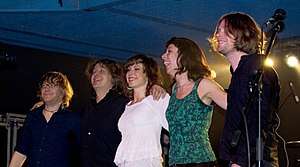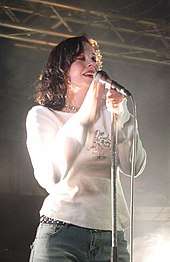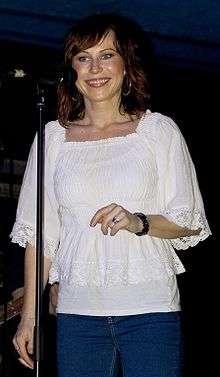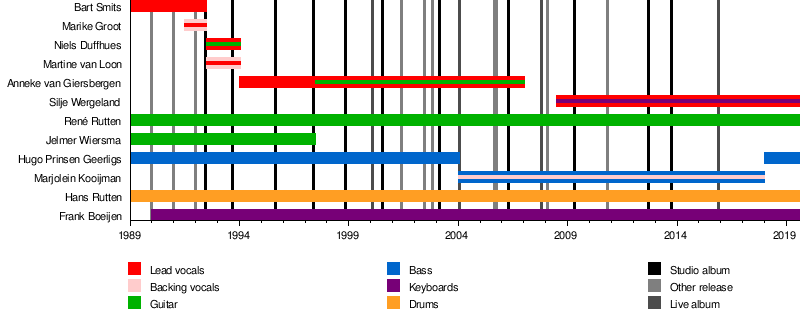The Gathering (band)
The Gathering is a Dutch rock band, founded in 1989 by brothers Hans and René Rutten and vocalist Bart Smits in Oss, North Brabant.
The Gathering | |
|---|---|
 Budapest concert, 31 January 2010 | |
| Background information | |
| Origin | Oss, the Netherlands |
| Genres | |
| Years active | 1989–2014, 2018–present |
| Labels |
|
| Associated acts | Agua de Annique, Habitants |
| Website | www |
| Members | René Rutten Hans Rutten Frank Boeijen Silje Wergeland Hugo Prinsen Geerligs |
| Past members | Jelmer Wiersma Bart Smits Marike Groot Niels Duffhues Martine van Loon Anneke van Giersbergen Marjolein Kooijman |
The Gathering earliest releases were categorized as atmospheric doom metal with influences from death metal acts like Celtic Frost and Hellhammer. In 1998 with the release of their fifth studio album, How to Measure a Planet?, they had a major shift in musical style, with the group acknowledging the growing influence of shoegazing, post-rock, experimental rock and the more ethereal sounds of 4AD bands, such as Dead Can Dance, Cocteau Twins, as well as Pink Floyd, Radiohead and Massive Attack; they expanded their sound, which acquired characteristics of progressive, alternative rock, and trip hop and gained success and recognition beyond the European borders. The group continue to expand upon the experimental nature of their music.
In August 2007 Anneke van Giersbergen left the group to focus on her solo project Agua de Annique.[1] On 12 March 2009, The Gathering announced that their replacement vocalist was Silje Wergeland (Octavia Sperati). Their most recent album, Afterwords, was released on 25 October 2013.
On 17 January 2014, the band announced that they decided to take a break from recording and touring, and also that Marjolein Kooijman left the band.[2] To celebrate the band's 25th anniversary, a show featuring most of current and past members of the band took place on 9 November 2014 and was released as a live album in 2015.[3]
History
Early years (1989–1994)
Founded by brothers Hans and René Rutten and vocalist Bart Smits, The Gathering formed in the city of Oss, North Brabant, Netherlands in 1989. Soon after they were joined by Hugo Prinsen Geerligs, Jelmer Wiersma and Frank Boeijen to complete their first line-up. The Gathering's earliest recordings were categorized as atmospheric doom metal with influences from death metal acts like Celtic Frost and Hellhammer.
In 1990 they recorded a demo tape entitled An Imaginary Symphony which met some positive reactions from the underground metal scene due to their unusual use of keyboards in metal-oriented music. A second demo, "Moonlight Archer" was recorded in April 1991, was picked up by several music journalists. Both demos suffered from poor production; however they did help establish the band's name on the live circuit opening for bands such as Dead Head, Invocator, Samael, Morbid Angel and Death.
After signing with Foundation 2000, the group released their debut album Always... in 1992. On this album, Bart Smits was accompanied by Marike Groot on vocals, who also joined The Gathering on stage for most of the gigs. the album was a minor success on the European continent, where it went on to shift nearly 20,000 units over the next few years.[4] In 1992 both Bart Smits and Marike Groot decided to leave the group due to musical differences; the other members wanted to change direction towards a lighter, more progressive sound.[5] Smits went on to form his own project, called Wish, to explore a darker, heavier sound.
In 1993 the group recruited two new vocalists, Niels Duffhues and female counterpart Martine van Loon. A second album, Almost a Dance, was recorded and released in 1993 by Foundation 2000. The album was met with much criticism aimed at Duffhues' punk-ish tone being decidedly out of step with the music, and the album was largely written off as a result.[6] The group collectively acknowledged their disappointments with Almost a Dance and decided to start writing new material and start the search for a new vocalist.
Century Media years (1995–2001)
The Gathering released their third album (and first to feature Anneke van Giersbergen) Mandylion in 1995 through Century Media; proving to be their breakthrough and selling over 130,000 copies in Europe. Two singles were released from Mandylion, "Adrenaline/Leaves" and "Strange Machines" (which charted in the Netherlands) further helped raise the group's popularity in Europe and the United States. Tours of Belgium and Germany, as well as appearances at the Dynamo Open Air and Pinkpop Festivals further established the bands presence in the European metal scene. 1997's Nighttime Birds was stylistically and musically a companion piece to Mandylion sold over 90,000 copies and saw the group tour throughout Europe.
In 1998 the group acknowledged their growing influences and their need to experiment with a double-album How to Measure a Planet?. Produced by Attie Bauw, the album is a radical departure from the group's established sound, characteristically experimental alternative, trip rock. Upon release, the album received excellent reviews from critics who appreciated the band's absorption of new styles such as shoegaze and trip hop into its sound. Positive reactions came from all over the world, including the United States, where they played 14 shows during the summer of 1999.
In 1999 the band formed their own record label, Psychonaut Records, with the view of releasing their own music and taking creative control over how their music is marketed and distributed. Always... was re-released in 1999, followed by Almost a Dance in 2000, both re-mastered and fitted with new artwork. However, the band were still under contract with Century Media, they released a live album Superheat (2000) which was recorded in several Dutch venues during 1999.
Another successful chapter in The Gathering's career followed with the release of if then else (2000). The album is filled with diverse, intense and emotional rock songs, more compact than its predecessor. Fifteen months of touring ensued, taking them to virtually every nook and cranny of Europe, with a little sidestep to Mexico, and ending with a small Dutch club tour in October 2001.
Independent years (2002–2008)

In 2002 the band members took a break and tended to their private lives. During this period, they ended their contract with Century Media. The Gathering had to run their new born label Psychonaut Records and their 12½-year anniversary was coming up. To celebrate this with their fans, they released the mini-CD Black Light District on their own label.
In early 2003, Souvenirs was released. Sleepy Buildings, a semi-acoustic live album, followed in 2004. This album was the last one featuring Hugo Prinsen Geerligs as the bass player. He was later replaced by Marjolein Kooijman.
In 2005, The Gathering provided the music for a CD-ROM titled "Passengers in Time: The Musical History Tour". This CD accompanied a history study book written by Professor Wim Kratsborn and the band did not consider it to be an official release of theirs.
The band released a DVD in 2005, entitled A Sound Relief. This contained more gentle semi-acoustic songs. But this is not their first DVD. Century Media had released In Motion without band permission at 2001. Nevertheless In Motion had an acceptable success. The next plan was to release in 2007 a second DVD (recognized for the band) A Noise Severe which features the more hard rock sound of The Gathering. This DVD was recorded in Santiago, Chile at 24 March 2007 at the Caupolicán Theatre.
In April 2006 they released their eighth studio album called Home. They had toured in March in North and South America and, after a brief pause to let van Giersbergen treat a laryngitis problem, they continued their touring schedule with European dates and music festivals throughout 2006.
The Gathering toured throughout the U.S. and Canada with Lacuna Coil in early 2007. On 5 June 2007, it was announced that Anneke was leaving The Gathering to spend more time with her family and her own band, Agua de Annique. The band scheduled a final tour stop on 4–5 August 2007 at the Ankkarock Festival, Finland. The Ankkarock Festival was announced as the final performance with Anneke as vocalist.
Departure of Anneke van Giersbergen, arrival of Silje Wergeland (2007–present)

In February 2008, The Gathering released a boxed set entitled Sand and Mercury - The Complete Century Media Years. This boxed set was limited to 3000 copies worldwide, and contained 10 discs including a selection of studio, live and compilation albums. The set also contained the audio from the In Motion DVD as a new live album, also entitled In Motion.
In September 2008, The Gathering released a collection of all their old material from 1989 to 1993 on a double CD. The album contains the demos, the never released promo 1992, live tracks and the Celtic Frost cover of "Dethroned Emperor". The songs were from the period of the first line-up with singer Bart Smits. All songs were restored and mastered by Mike Wead (King Diamond / Mercyful Fate) and was released by small Dutch independent label Vic Records.
The Gathering's ninth studio album, The West Pole, was released in May 2009, shortly after being joined by a new singer, Silje Wergeland.
On 16 May 2011, the band released the single "Heroes for Ghosts" via their Bandcamp page, as well as announcing a South American tour. The song would be featured on the then-forthcoming album.[7]
On 12 September 2012, the band released their tenth studio album, Disclosure.
The Gathering celebrated their 25th birthday as a band with two sold-out reunion concerts at Doornroosje, in Nijmegen (Netherlands), on 9 November 2014. It was the first time that four of their singers (Bart Smits, Marike Groot, Anneke van Giersbergen and Silje Wergeland) performed together, and the band's first performance with van Giersbergen since her departure in 2007.
On 8 December 2016, they surprise released a double-disc of outtakes, demos & unreleased songs from the recordings of Souvenirs and Home, called Blueprints.
In June and November 2018, they played several shows in the Netherlands and did a small tour in Greece.[8]
Etymology
Frank Boeijen on the origins of the name of the band:
"The name the Gathering has been made like eleven years ago when we started this band. We were all between 15 and 17. We were watching a lot of movies those days. One of the movies spoke about immortality and that you could kill the immortals with cutting their head off [it's the first Highlander Frank is speaking about]. In the first part of the movie, they speak a lot about the gathering. There will be a gathering once with all the immortals. We thought it was a nice name for a band, and that's how we created this name. And you can feel it's a cool name for five people who come together to make fine music." (sic)[9]
Members
|
Current lineup
|
Former members
|
Timeline

Discography
- Always... (1992)
- Almost a Dance (1993)
- Mandylion (1995)
- Nighttime Birds (1997)
- How to Measure a Planet? (1998)
- if_then_else (2000)
- Souvenirs (2003)
- Home (2006)
- The West Pole (2009)
- Disclosure (2012)
- Afterwords (2013)
References
- "Former The Gathering Singer Launches Agua De Annique". Roadrunnerrecords.com. Archived from the original on 6 June 2011. Retrieved 19 February 2012.
- "theGathering - Dear friends, With some great shows and the..." Facebook.com. Retrieved 20 May 2015.
- "Special Anniversary Show". Facebook.com. Retrieved 20 May 2015.
- "Vic Records". Vicrecords.com. Retrieved 19 February 2012.
- "Interview with Bart Smits, ex-vocalist of THE GATHERING van Albert DiBenedetto (Kreavis B. Gribble) op Myspace". Myspace.com. 31 August 2010. Retrieved 19 February 2012.
- Bickers, James. "The Gathering". AllMusic. Retrieved 19 February 2012.
- "THE GATHERING Offer New 'Heroes Of Ghosts' Track For Free Download". Bravewords.com. Retrieved 20 May 2015.
- "Search for setlists: artist:(The Gathering) date:[2018-01-01 TO 2018-12-31] - setlist.fm". www.setlist.fm. Retrieved 4 February 2019.
- "The Gathering". Gathering.nl. Retrieved 19 February 2012.
External links
| Wikimedia Commons has media related to The Gathering. |
- Official website
- The Gathering discography at Discogs
